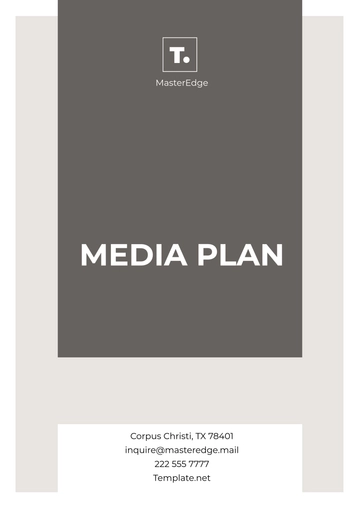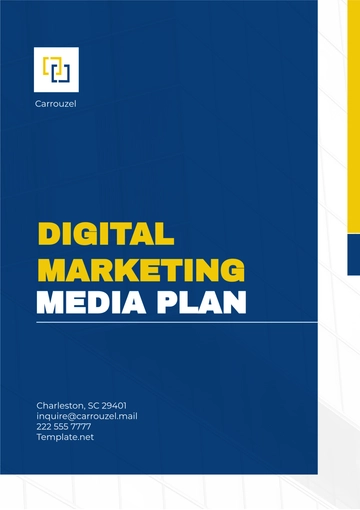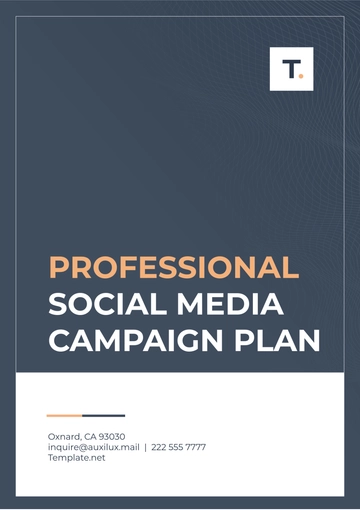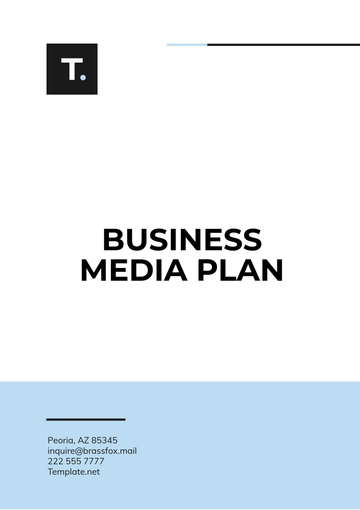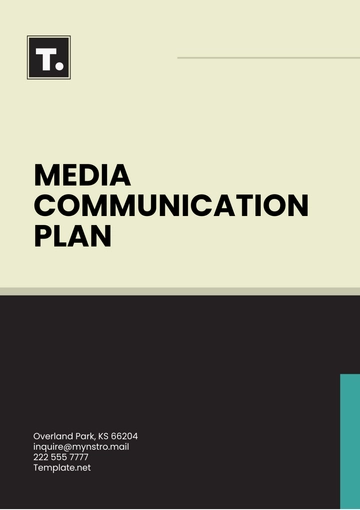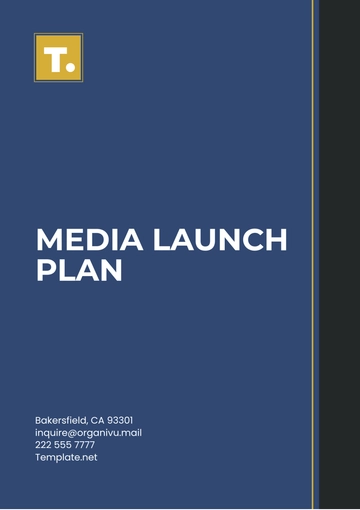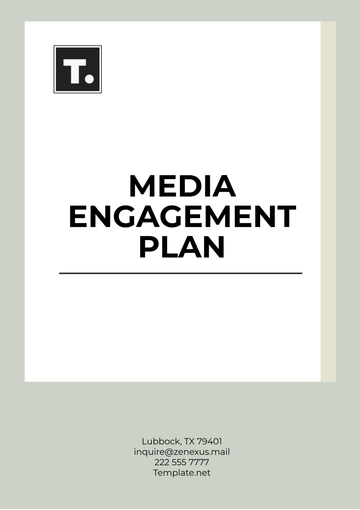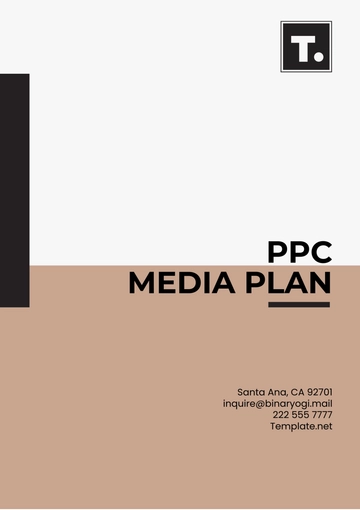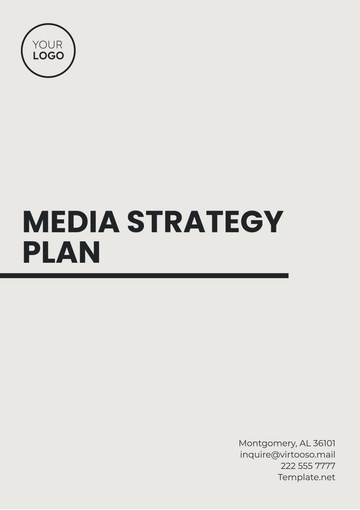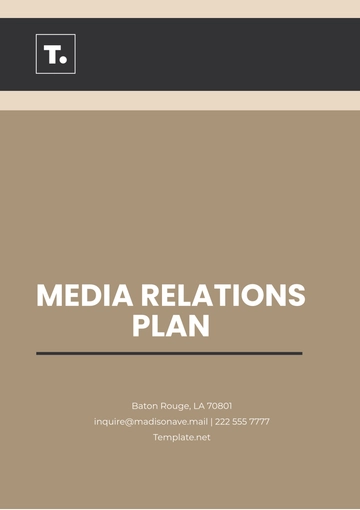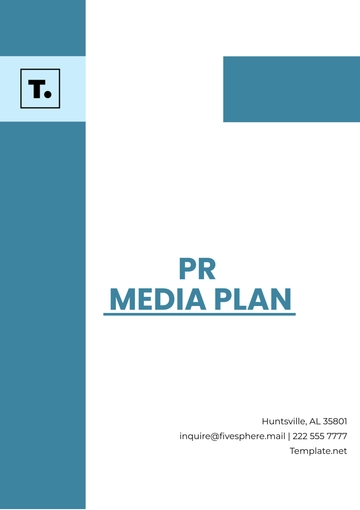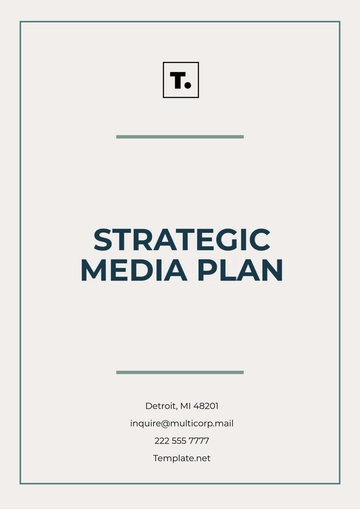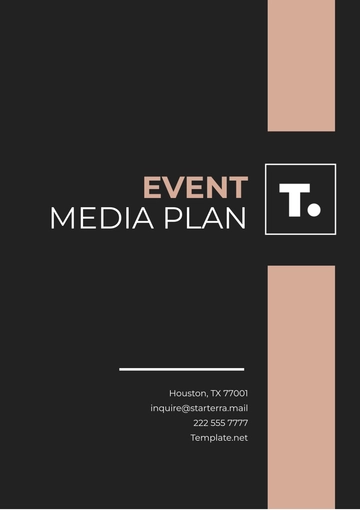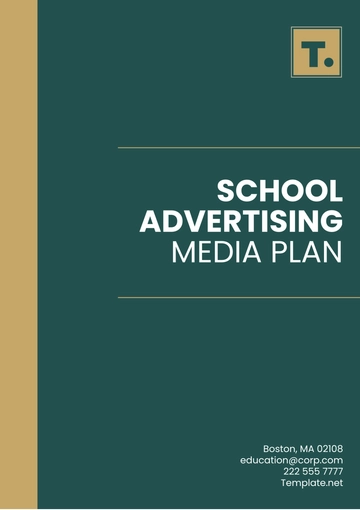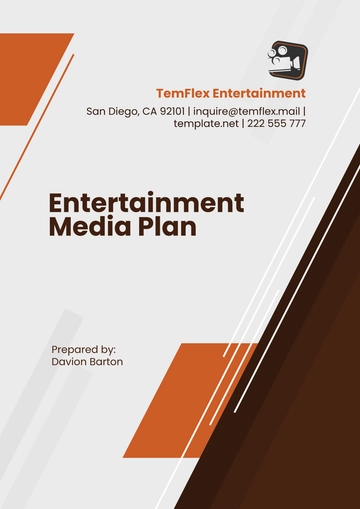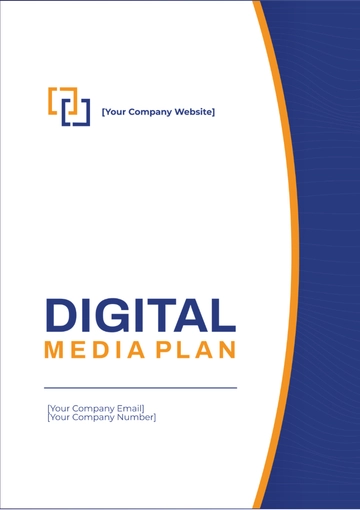Free Entertainment Media Plan
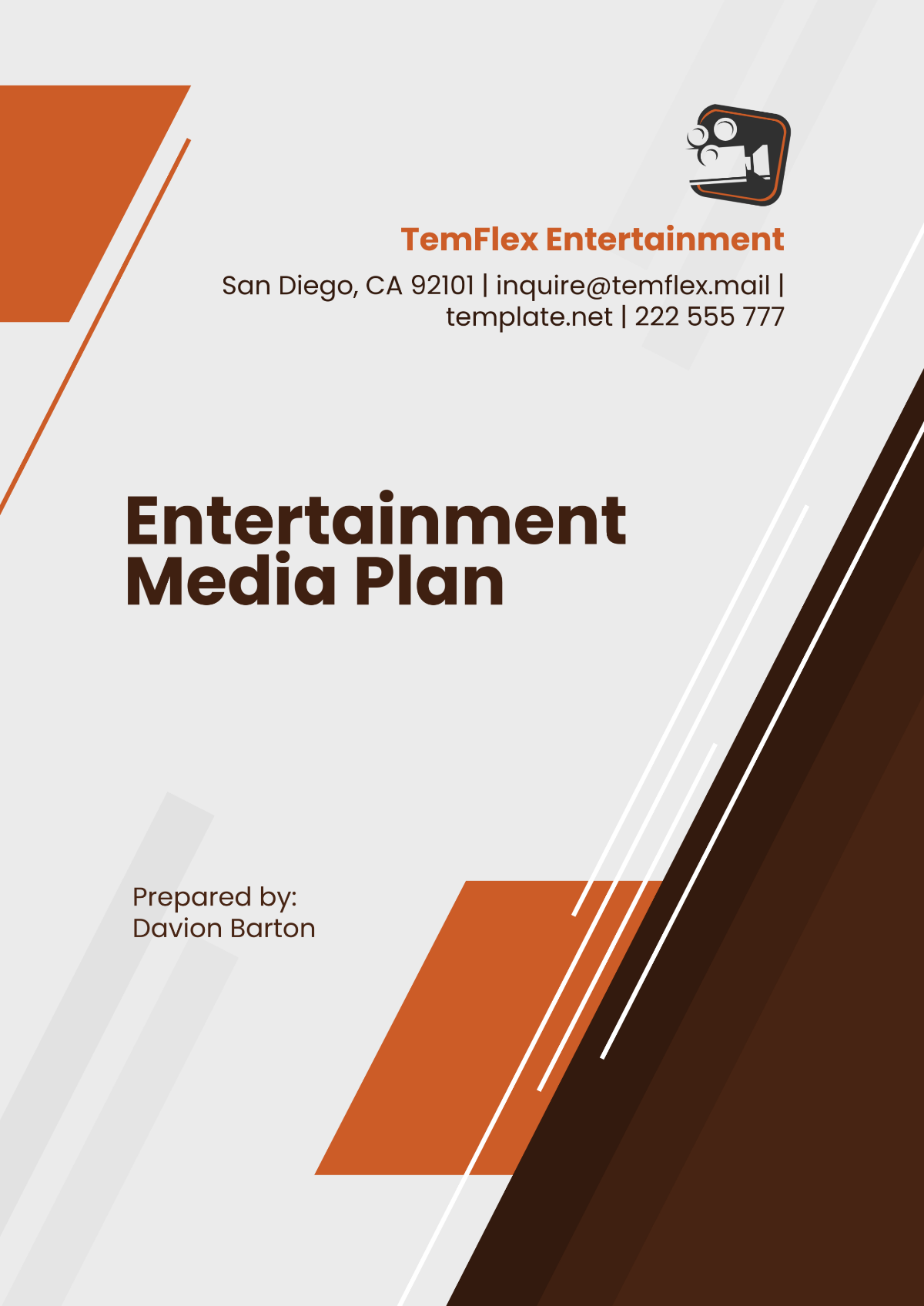
I. Executive Summary
In the rapidly evolving entertainment industry, [Your Company Name] has set ambitious goals for expanding its presence and maximizing its impact on both global and niche markets. With technological advancements and shifting audience preferences driving change, the need for a dynamic, multi-faceted media strategy has never been more critical. This Entertainment Media Plan lays out a detailed roadmap to guide [Your Company Name] in navigating the ever-changing entertainment landscape from 2050 to 2055. By implementing this plan, [Your Company Name] aims to increase revenue by [$50 million] over the first two years while boosting its digital footprint, fostering strong audience engagement, and ensuring high levels of brand visibility.
The plan focuses on audience analytics, digital transformation, and strategic collaborations. Key to its success will be a comprehensive distribution strategy that spans streaming platforms, social media, traditional media, and exclusive events, all while maintaining an unwavering commitment to delivering high-quality content. The expansion of content production capabilities, along with optimizing distribution networks, will propel [Your Company Name] to new levels of success, reaching wider audiences, and solidifying its position as an industry leader.
II. Objectives
A. Strategic Objectives
Maximize Audience Reach
One of the primary goals for [Your Company Name] is to broaden its audience base. This means reaching new audiences and cultivating deeper relationships with existing viewers. The company aims to target both established fan bases and younger, digitally native consumers who are keen on engaging with content across multiple channels. By expanding the company's presence on streaming platforms such as Netflix, Amazon Prime, and Disney+, as well as developing its proprietary app, [Your Company Name] will be able to reach a wide array of global markets. This expansion is expected to increase audience engagement by [20%] year-on-year, helping us to build a loyal following and improve customer retention.Increase Revenue Streams
[Your Company Name] is committed to diversifying its revenue streams beyond traditional movie ticket sales and television programming. While content sales remain important, the focus will shift toward other monetization channels such as subscription models, merchandising, gaming, and sponsored content. By the end of 2051, the company is targeting a [$15 million] increase in annual revenue, driven primarily by subscription-based platforms, branded content, and strategic licensing partnerships with major tech firms and broadcast networks. Through the implementation of new revenue models, the goal is to have a consistent and sustainable financial performance.Strengthen Brand Identity
As competition in the entertainment industry intensifies, it is essential for [Your Company Name] to maintain a strong, recognizable brand. This objective involves the creation of compelling content that speaks to core values of innovation, creativity, and inclusivity, positioning [Your Company Name] as a leader in producing high-quality and culturally relevant content. The brand will leverage influencer marketing, public relations campaigns, and cross-platform promotions to maintain its visibility in the marketplace. Achieving brand differentiation in a crowded space will be key to attracting new audiences and retaining loyal fans.
B. Operational Goals
Content Production
In order to remain competitive, [Your Company Name] must significantly increase the volume and quality of its content production. The company plans to release a combination of five original films, eight series, and ten music albums every year starting from 2050. Additionally, there will be a focus on producing both short-form and long-form content to cater to changing audience preferences. With an estimated budget of [$40 million] per year for content production, the company will focus on creating content across various genres, including sci-fi, drama, comedy, and action, ensuring that the content appeals to diverse demographics across the globe.Data-Driven Decision Making
[Your Company Name] will adopt an advanced analytics system to leverage data for content creation, marketing, and audience engagement strategies. By integrating artificial intelligence (AI) tools, the company will be able to track real-time audience preferences, predict trends, and measure the impact of campaigns across various platforms. Using this information, the company will make more informed decisions about content production and distribution, ultimately enhancing the user experience and ensuring higher viewer satisfaction.Platform Optimization
The company's digital platforms will undergo significant improvements to enhance user experience. This includes redesigning the website and mobile apps for more intuitive navigation, increasing interactivity features, and incorporating AI-powered recommendations. These upgrades will be completed by the second quarter of 2051, with a focus on retaining subscribers and improving the usability of the platform. As the entertainment landscape becomes more integrated with technological advancements such as virtual reality (VR) and augmented reality (AR), [Your Company Name] will also look to adopt these technologies to create immersive content experiences for its audience.
III. Target Audience
A. Primary Demographics
Age Range: [18–35 years]
The primary demographic for [Your Company Name] consists of individuals aged [18–35], a group that is highly tech-savvy and deeply engaged in digital content consumption. This demographic is driven by a desire for interactive, diverse, and high-quality content, often seeking drama, sci-fi, gaming, and music genres. This age group represents a significant percentage of global streaming subscribers, making it a crucial focus for the company’s marketing efforts. As a result, [Your Company Name] will tailor its content to be relatable to this audience through the inclusion of relevant themes, diverse storytelling, and cutting-edge production techniques.Geographic Focus
The target market will span multiple regions, with a particular focus on North America (representing [40%] of the target market), Europe ([30%]), and Asia ([20%]). Specific attention will be given to high-growth markets in India and China, which are seeing rapid adoption of digital platforms and have an expanding middle class eager for diverse content. Tailored marketing campaigns and culturally relevant productions will be developed for these markets to ensure local relevance and engagement.
B. Secondary Demographics
Age Range: [35–50 years]
The secondary demographic will consist of individuals aged [35–50], an audience that is typically more established in their careers and seeks content that resonates with their personal experiences. This group is interested in nostalgic content, documentaries, and family-friendly programming. To cater to this audience, [Your Company Name] will invest in producing historical drama series, family films, and documentaries, as well as reviving beloved classics to tap into the sentimental value this demographic holds for certain genres.Cultural Representation
As part of the company’s commitment to diversity and inclusion, content will be created with global cultural representation in mind. [Your Company Name] will aim to create universal narratives that resonate across multiple cultures while ensuring that local customs, beliefs, and stories are accurately portrayed. The company will also prioritize collaborating with international talent, from actors and directors to writers and producers, to ensure that content reflects the richness of global cultures.
IV. Media Channels and Distribution
A. Digital Channels
Streaming Platforms
One of the primary ways in which [Your Company Name] will distribute content is through streaming platforms. These platforms, including Netflix, Amazon Prime Video, Hulu, and [Your Company Name]’s proprietary app, will be leveraged to release exclusive content, driving subscription and viewer engagement. To meet the demand for on-demand viewing, the company will release five major films and [eight] TV series per year, ensuring a consistent flow of fresh, high-quality content. This approach is expected to increase subscribers by [30%] annually.Social Media
In addition to traditional media, social media platforms such as Instagram, TikTok, YouTube, and emerging platforms will play a crucial role in connecting with audiences. Campaigns across these platforms will be highly interactive and visually engaging, including behind-the-scenes content, viral challenges, and teasers for upcoming releases. The budget for social media campaigns is expected to be [$2 million] annually, which will be spent on influencer collaborations, paid promotions, and community-building activities.
Social Media Platform | Target Audience (%) | Content Type | Annual Budget ($) |
|---|---|---|---|
60 | Short-form videos, updates | 800,000 | |
TikTok | 30 | Viral challenges, teasers | 600,000 |
YouTube | 80 | Full-length trailers, Vlogs | 400,000 |
Emerging Platforms | 20 | Niche content experiments | 200,000 |
B. Traditional Media
Television and Radio
While digital platforms will remain the primary distribution channel, traditional media will still play an essential role in reaching broader demographics. Television and radio ads will be utilized to promote major premieres, awards shows, and events to an older, more traditional audience. The budget allocation for television and radio advertising is set at [$3 million] annually, with specific focus on prime-time slots and well-established networks.Print Media
Although print media is no longer the primary source of information, magazines and newspapers still offer value in reaching specific target groups, particularly in the case of awards campaigns and niche market segments. For print campaigns, the budget allocation is [$1 million] annually, to cover magazine features, special supplements, and event promotions.
V. Marketing and Advertising Strategy
A. Core Campaigns
Global Launch Events
To generate excitement and anticipation for major releases, [Your Company Name] will organize large-scale global launch events, which will be streamed online to provide fans with access to exclusive behind-the-scenes content, Q&A sessions with cast and creators, and live performances. Each launch event is expected to cost around [$5 million], and the goal is to attract a global audience of [50 million+] viewers, creating a buzz that extends to social media platforms, online publications, and other media outlets.Seasonal Promotions
In addition to these global campaigns, [Your Company Name] will run seasonal promotions during major holidays and cultural events, including New Year's, Halloween, and global festivals like Diwali and Chinese New Year. The company expects these campaigns to result in a [30%] uplift in merchandise sales and streaming subscriptions, as audiences look for new content to enjoy during festive seasons.
B. Partnerships and Sponsorships
Collaborations with Influencers
To expand its reach further, [Your Company Name] will collaborate with over [50] influencers from various fields, including film, music, fashion, and gaming, to promote key content and engage with fans on social media. These partnerships will provide access to a combined audience of over [100 million] followers across various platforms. With an annual budget of [$2 million] for influencer marketing, [Your Company Name] will strategically choose influencers whose brand aligns with the company’s values and content offerings.Brand Partnerships
In addition to influencer marketing, [Your Company Name] will also pursue brand partnerships with tech companies for cross-promotional campaigns. For example, partnering with a VR headset company for product tie-ins, or collaborating with a mobile gaming platform to create companion games for major releases. These partnerships will generate an estimated [$10 million] in joint revenue by 2055, leveraging the crossover between entertainment and technology.
VI. Financial Projections
Financial projections over the next five years anticipate a steady growth trajectory for [Your Company Name], with revenue increasing from [$50 million] in 2050 to [$110 million] by 2054. This growth will be driven by the expansion of content production, increased audience engagement, and the diversification of revenue streams. Operating costs will increase in line with content development and marketing expenditures, but the company's strong financial discipline will ensure that profitability remains high.
Year | Revenue Target ($ Million) | Operating Costs ($ Million) | Profit Margin (%) |
|---|---|---|---|
2050 | 50 | 30 | 40 |
2051 | 60 | 35 | 41.6 |
2052 | 75 | 40 | 46.7 |
2053 | 90 | 45 | 50 |
2054 | 110 | 50 | 54.5 |
VII. Content Strategy
A. Original Productions
Films
[Your Company Name] will focus on a diverse mix of genres, with an emphasis on high-concept science fiction, action films, and drama. Each film will be budgeted at [$5 million], with the goal of generating a box office return of [$15 million] per release. This balanced approach will ensure that content is appealing to a wide range of audiences, from mainstream to niche.Series
A mix of both short-form and long-form episodic content will be produced, offering something for every viewer. The series production budget is estimated at [$8 million] annually, which will cover script development, talent fees, and filming costs. [Your Company Name] will focus on creating compelling, binge-worthy content to capture and retain viewers.Music and Gaming
Music will also play a pivotal role in the company’s content strategy. [Your Company Name] plans to release a variety of soundtracks alongside major films and series, generating additional revenue through licensing deals and streaming platforms. Additionally, gaming partnerships will create interactive fan experiences tied to film and television properties. This cross-medium approach ensures the company taps into a broader entertainment ecosystem.
B. Licensing and Syndication
Licensing and syndication of content will become a key revenue driver for [Your Company Name]. By securing deals with broadcasters in emerging markets, the company expects to generate approximately [$20 million] in syndication revenue by 2055, increasing its global footprint and visibility. This strategy will include both traditional licensing arrangements with networks and more innovative digital syndication deals with streaming platforms.
VIII. Monitoring and Evaluation
A. Key Performance Indicators (KPIs)
To assess the success and efficiency of the Entertainment Media Plan, [Your Company Name] will closely monitor a set of Key Performance Indicators (KPIs) that align with its strategic goals. These KPIs will be tracked across various departments, from content production to marketing, to ensure that every aspect of the plan is progressing as intended. Regular evaluation of these metrics will also allow for adjustments to be made in real-time to improve overall outcomes.
Engagement Metrics
Engagement metrics are central to measuring the effectiveness of content distribution and marketing efforts. These metrics will allow [Your Company Name] to gauge the level of interaction between the brand and its audience, as well as the overall sentiment around the company’s media offerings.Social Media Interactions
One of the core measures of audience engagement is the level of interaction on social media platforms, such as likes, shares, comments, and mentions. The goal is to generate a minimum of [10 million+] social media interactions per campaign, ensuring that the content resonates with viewers and stimulates conversation. The company will use social listening tools to track real-time audience feedback and incorporate insights into future content creation.App Downloads and Usage
As part of its digital expansion strategy, [Your Company Name] plans to enhance its proprietary app to serve as a hub for exclusive content. The company expects to increase app downloads by [5 million+] annually through targeted promotions and content exclusivity. Additionally, engagement with the app, including usage rates, session durations, and active users, will be monitored to assess its performance. The goal is to maintain a [30%] increase in daily active users year-over-year.
Revenue Tracking
Revenue metrics will be crucial to evaluating the financial success of the media plan. These KPIs will help measure the impact of content creation and marketing efforts on overall profitability.Monthly Subscription Growth
A significant part of [Your Company Name]’s revenue model will come from subscription services. The company expects a steady monthly growth rate of [5%] in subscribers across its platforms. This will be closely tracked through internal analytics systems that monitor new subscriptions, churn rates, and overall customer retention. The goal is to consistently increase the subscriber base while reducing churn, ensuring steady revenue growth.Merchandise Sales
As part of diversifying revenue streams, [Your Company Name] will also focus on expanding its merchandise offerings, including branded clothing, collectibles, and limited edition items tied to popular films and series. Merchandise sales are projected to increase by [25%] during promotional periods. Monitoring merchandise sales through both online and retail channels will be essential to evaluate the success of these campaigns. Special releases tied to major events, such as movie premieres or festivals, will be key to driving this revenue.Licensing and Syndication Revenue
Another critical revenue stream for [Your Company Name] will be licensing and syndication of its content to international broadcasters and digital platforms. The company projects that licensing agreements will generate approximately [$20 million] in revenue by 2055. This will require constant monitoring of licensing negotiations, syndication deals, and the overall demand for the company’s catalog of content.
Content Performance Metrics
Understanding how individual pieces of content perform in the market is vital to adjusting production and distribution strategies. KPIs related to content performance include:Viewer Retention Rates
Retaining viewers throughout the entirety of a movie or series is a critical metric for determining the success of the content. [Your Company Name] will track viewer retention rates across streaming platforms to ensure that audiences are staying engaged with the content over its full duration. The company aims for a minimum retention rate of [75%] for series and [80%] for movies on its digital platforms.Content Consumption Time
Tracking the average time spent by viewers watching content is another key performance indicator. This data will help the company gauge how invested viewers are in its content and how likely they are to continue engaging with future productions. The goal is to increase the average viewing time per user by [20%] year-over-year.
B. Feedback Loops
Audience Feedback
To maintain a dynamic, responsive strategy, [Your Company Name] will continuously solicit feedback from its audiences. This will be achieved through a combination of direct surveys, social media monitoring, and focus groups. Viewer satisfaction surveys will be deployed after every major release, focusing on aspects such as plot, pacing, character development, and overall enjoyment. This direct feedback will inform future content creation, allowing the company to better align with audience preferences.Real-Time Analytics
Leveraging artificial intelligence and data analytics tools, [Your Company Name] will collect real-time data from multiple sources, including streaming platforms, social media, and mobile apps. By tracking how content is consumed, where it is most popular, and when viewers are dropping off, the company will be able to fine-tune its approach and improve future content offerings. These insights will also inform marketing strategies and help tailor campaigns for maximum impact.Influencer and Public Relations Feedback
Influencer collaborations and public relations efforts will also be evaluated regularly. The company will measure the effectiveness of partnerships by tracking engagement levels, sentiment, and brand visibility across various platforms. Feedback from influencers and media partners will be used to refine future collaborations and marketing initiatives.
IX. Risks and Mitigation Strategies
A. Identified Risks
Market Saturation
The entertainment market, particularly in the digital space, is becoming increasingly saturated, with an ever-growing number of streaming services, production companies, and content creators vying for audience attention. This saturation can lead to diminishing returns on new content investments, making it harder to maintain subscriber growth and audience engagement.Mitigation Strategy
To combat market saturation, [Your Company Name] will focus on differentiating itself through high-quality, niche content that appeals to underserved markets. Additionally, the company will capitalize on cutting-edge technologies such as virtual reality (VR) and augmented reality (AR) to offer immersive, interactive content experiences that stand out from the competition. Targeted, data-driven marketing will also help ensure content reaches the most relevant audiences.
Technological Barriers
While technological advancements, such as AI-driven recommendations and immersive content experiences, offer substantial opportunities, they also present risks, including integration challenges, platform incompatibility, and unforeseen technological costs. For example, implementing AR/VR experiences may require significant investments in equipment and infrastructure.Mitigation Strategy
To address these risks, [Your Company Name] will partner with established technology firms and hire technical experts who are adept at integrating cutting-edge solutions. The company will also adopt a phased approach to technology adoption, starting with smaller, manageable projects to test new technologies before committing to large-scale implementations. This approach ensures that technological advancements align with the company’s overall strategic goals and budget.
Economic Fluctuations
Economic downturns, such as recessions or financial crises, can have a significant impact on consumer spending habits, potentially leading to reduced disposable income for entertainment subscriptions and purchases. Additionally, advertising revenue may decline in tougher economic conditions.Mitigation Strategy
In the event of an economic downturn, [Your Company Name] will implement flexible pricing models, including discounted subscription rates, to retain subscribers. The company will also expand its focus on alternative revenue streams such as branded content, partnerships, and merchandise, which are less reliant on consumer spending power. Developing a diversified revenue model will help the company weather any economic challenges that may arise.
Content Production Delays
Delays in content production can occur for various reasons, such as talent availability, unforeseen technical issues, or supply chain disruptions. These delays can disrupt the planned release schedule, which may negatively impact audience expectations and revenue.Mitigation Strategy
To minimize the impact of production delays, [Your Company Name] will maintain a content production buffer by creating a pipeline of projects that are in various stages of development. This way, even if one project experiences delays, the company will have other content ready for release. Additionally, the company will invest in robust project management tools to ensure production timelines are met.
X. Implementation Timeline
The timeline for executing the Entertainment Media Plan spans from the start of 2050 to 2055. This timeline provides clear milestones for content production, marketing initiatives, technology adoption, and revenue targets.
Phase | Timeline | Key Activities |
|---|---|---|
Planning | Q1 2050 | Finalize budgets, secure partnerships, and set up internal teams. Establish content themes and project pipelines. |
Production | Q2–Q4 2050 | Begin content production (films, series, music). Establish partnerships with tech companies. Start the development of VR/AR content. |
Launch | Q1 2051 | Premiere first major release. Launch marketing campaigns, influencer collaborations, and media partnerships. |
Evaluation | Annually (2051–2055) | Track KPIs, review content performance, and adjust strategies. Conduct focus groups and surveys to gauge audience sentiment. |
Expansion | Q3 2053 | Expand into new international markets. Increase production output, with a goal of releasing 10 films and 12 series annually by 2055. |
Diversification | Q4 2054–2055 | Launch new revenue models, including interactive gaming and VR/AR experiences. Target new audience segments through personalized content. |
This comprehensive timeline ensures that [Your Company Name] remains on track with its expansion plans while providing enough flexibility to adapt to changing market conditions. By 2055, [Your Company Name] aims to be a global leader in the entertainment industry, with a diversified portfolio, strong international presence, and substantial revenue generation across multiple channels.
- 100% Customizable, free editor
- Access 1 Million+ Templates, photo’s & graphics
- Download or share as a template
- Click and replace photos, graphics, text, backgrounds
- Resize, crop, AI write & more
- Access advanced editor
Organize your media strategies effectively with the Entertainment Media Plan Template from Template.net. This editable and customizable template helps you outline your media goals, platforms, and timelines. Customize it with the AI Editor Tool for streamlined media planning.
You may also like
- Finance Plan
- Construction Plan
- Sales Plan
- Development Plan
- Career Plan
- Budget Plan
- HR Plan
- Education Plan
- Transition Plan
- Work Plan
- Training Plan
- Communication Plan
- Operation Plan
- Health And Safety Plan
- Strategy Plan
- Professional Development Plan
- Advertising Plan
- Risk Management Plan
- Restaurant Plan
- School Plan
- Nursing Home Patient Care Plan
- Nursing Care Plan
- Plan Event
- Startup Plan
- Social Media Plan
- Staffing Plan
- Annual Plan
- Content Plan
- Payment Plan
- Implementation Plan
- Hotel Plan
- Workout Plan
- Accounting Plan
- Campaign Plan
- Essay Plan
- 30 60 90 Day Plan
- Research Plan
- Recruitment Plan
- 90 Day Plan
- Quarterly Plan
- Emergency Plan
- 5 Year Plan
- Gym Plan
- Personal Plan
- IT and Software Plan
- Treatment Plan
- Real Estate Plan
- Law Firm Plan
- Healthcare Plan
- Improvement Plan
- Media Plan
- 5 Year Business Plan
- Learning Plan
- Marketing Campaign Plan
- Travel Agency Plan
- Cleaning Services Plan
- Interior Design Plan
- Performance Plan
- PR Plan
- Birth Plan
- Life Plan
- SEO Plan
- Disaster Recovery Plan
- Continuity Plan
- Launch Plan
- Legal Plan
- Behavior Plan
- Performance Improvement Plan
- Salon Plan
- Security Plan
- Security Management Plan
- Employee Development Plan
- Quality Plan
- Service Improvement Plan
- Growth Plan
- Incident Response Plan
- Basketball Plan
- Emergency Action Plan
- Product Launch Plan
- Spa Plan
- Employee Training Plan
- Data Analysis Plan
- Employee Action Plan
- Territory Plan
- Audit Plan
- Classroom Plan
- Activity Plan
- Parenting Plan
- Care Plan
- Project Execution Plan
- Exercise Plan
- Internship Plan
- Software Development Plan
- Continuous Improvement Plan
- Leave Plan
- 90 Day Sales Plan
- Advertising Agency Plan
- Employee Transition Plan
- Smart Action Plan
- Workplace Safety Plan
- Behavior Change Plan
- Contingency Plan
- Continuity of Operations Plan
- Health Plan
- Quality Control Plan
- Self Plan
- Sports Development Plan
- Change Management Plan
- Ecommerce Plan
- Personal Financial Plan
- Process Improvement Plan
- 30-60-90 Day Sales Plan
- Crisis Management Plan
- Engagement Plan
- Execution Plan
- Pandemic Plan
- Quality Assurance Plan
- Service Continuity Plan
- Agile Project Plan
- Fundraising Plan
- Job Transition Plan
- Asset Maintenance Plan
- Maintenance Plan
- Software Test Plan
- Staff Training and Development Plan
- 3 Year Plan
- Brand Activation Plan
- Release Plan
- Resource Plan
- Risk Mitigation Plan
- Teacher Plan
- 30 60 90 Day Plan for New Manager
- Food Safety Plan
- Food Truck Plan
- Hiring Plan
- Quality Management Plan
- Wellness Plan
- Behavior Intervention Plan
- Bonus Plan
- Investment Plan
- Maternity Leave Plan
- Pandemic Response Plan
- Succession Planning
- Coaching Plan
- Configuration Management Plan
- Remote Work Plan
- Self Care Plan
- Teaching Plan
- 100-Day Plan
- HACCP Plan
- Student Plan
- Sustainability Plan
- 30 60 90 Day Plan for Interview
- Access Plan
- Site Specific Safety Plan
